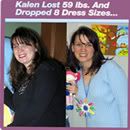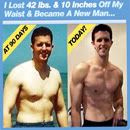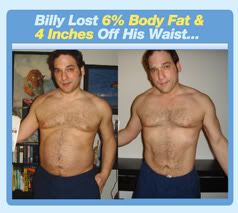Low carb (carbohydrate), high protein diets are the latest dieting craze. However, before you jump on the band wagon, you may want to consider a few things:
1. Low carb (ketogenic) diets deplete the healthy glycogen (the storage form of glucose) stores in your muscles and liver. When you deplete glycogen stores, you also dehydrate, often causing the scale to drop significantly in the first week or two of the diet. This is usually interpreted as fat loss when it’s actually mostly from dehydration and muscle loss. By the way, this is one of the reasons that low carb diets are so popular at the moment - there is a quick initial, but deceptive drop in scale weight.
Glycogenesis (formation of glycogen) occurs in the liver and muscles when adequate quantities of carbohydrates are consumed - very little of this happens on a low carb diet.
Glycogenolysis (breakdown of glycogen) occurs when glycogen is broken down to form glucose for use as fuel.
2. Depletion of muscle glycogen causes you to fatigue easily, and makes exercise and movement uncomfortable. Research indicates that muscle fatigue increases in almost direct proportion to the rate of depletion of muscle glycogen. Bottom line is that you don’t feel energetic and you exercise and move less (often without realizing it) which is not good for caloric expenditure and basal metabolic rate (metabolism).
3. Depletion of muscle glycogen leads to muscle atrophy (loss of muscle). This happens because muscle glycogen (broken down to glucose) is the fuel of choice for the muscle during movement. There is always a fuel mix, but without muscle glycogen, the muscle fibers that contract, even at rest to maintain muscle tone, contract less when glycogen is not immediately available in the muscle. Depletion of muscle glycogen also causes you to exercise and move less than normal which leads to muscle loss and the inability to maintain adequate muscle tone.
Also, in the absence of adequate carbohydrate for fuel, the body initially uses protein (muscle) and fat. the initial phase of muscle depletion is rapid, caused by the use of easily accessed muscle protein for direct metabolism or for conversion to glucose (gluconeogenesis) for fuel. Eating excess protein does not prevent this because there is a caloric deficit.
When insulin levels are chronically too low as they may be in very low carb diets, catabolism (breakdown) of muscle protein increases, and protein synthesis stops.
4. Loss of muscle causes a decrease in your basal metabolic rate (metabolism). Metabolism happens in the muscle. Less muscle and muscle tone means a slower metabolism which means fewer calories burned 24 hours-a-day.
5. Your muscles and skin lack tone and are saggy. Saggy muscles don’t look good, cause saggy skin, and cause you to lose a healthy, vibrant look (even if you’ve also lost fat).
6. Some proponents of low carb diets recommend avoiding carbohydrates such as bread, pasta, potatoes, carrots, etc. because of they are high on the glycemic index - causing a sharp rise in insulin. Certain carbohydrates have always been, and will always be the bad guys: candy, cookies, baked goods with added sugar, sugared drinks, processed / refined white breads, pastas, and rice, and any foods with added sugar. These are not good for health or weight loss.
However, carbohydrates such as fruits, vegetables, legumes, whole grain breads and pastas, and brown rice are good for health and weight loss. Just like with proteins and fats, these carbohydrates should be eaten in moderation. Large volumes of any proteins, fats or carbohydrates are not conducive to weight loss and health.
The effect of high glycemic foods is often exaggerated. It does matter, but to a smaller degree than is often portrayed. Also, the total glycemic effect of foods is influenced by the quantity of that food that you eat at a sitting. Smaller meals have a lower overall glycemic effect. Also, we usually eat several types of food at the same time, thereby reducing the average glycemic index of the meal, if higher glycemic foods are eaten.
Also, glycemic index values can be misleading because they are based on a standard 50 grams of carbohydrate consumed. It wouldn’t take much candy bar to get that, but it would take four cups of carrots. Do you usually eat four cups of carrots at a meal?
Regular exercisers and active people also are less effected by higher glycemic foods because much of the carbohydrate comsumed is immediately used to replenish glycogen stores in the liver and muscle.
7. Much of the weight loss on a low carb, high protein diet, especially in the first few weeks, is actually because of dehydration and muscle loss.
8. The percentage of people that re-gain the weight they’ve lost with most methods of weight loss is high, but it’s even higher with low carb, high protein diets. This is primarily due to three factors:
A. You have lost muscle. With that comes a slower metabolism which means fewer calories are burned 24 hours-a-day. A loss of muscle during the process of losing weight is almost a guarantee for re-gaining the lost weight, and more.
B. You re-gain the healthy fluid lost because of glycogen depletion.
C. It’s difficult to maintain that type of diet long-term.
D. You have not made a change to a long-term healthy lifestyle.
9. Eating too much fat is just not healthy. I know you’ve heard of people whose blood levels of cholesterol and triglycerides have decreased while on a low carb, high protein diet. This often happens with weight loss, but it doesn’t continue when you’re on a diet high in fat.
There are literally reams of research over decades that clearly indicates that an increase in consumption of animal products and/or saturated fat leads to increased incidence of heart disease, strokes, gall stones, kidney stones, arthritic symptoms, certain cancers, etc. For example, in comparing countries with varying levels of meat consumption, there is a direct relationship between the volume of meat consumption in a country and the incidence of digestive cancers (stomach, intestines, rectal, etc.).
Fat is certainly necessary, and desirable in your diet, but they should be mostly healthy fats and in moderation. Manufactured / synthetic “low fat” foods with lots of added sugar are not the answer. Neither are manufactured / synthetic “low carb” foods with artificial sweeteners or added fat. By the way, use of artificial sweeteners has never been shown to aid in weight loss and they may pose health problems.
According to Dr. Keith-Thomas Ayoob of Albert Einstein College of Medicine in New York, “In my experience, unless you’re willing to throw out decades of research, you cannot ignore that diets chronically high in saturated fats are linked to heart disease,” Dr. Ayoob is also a spokesman for the American Dietetic Association and says that low carb, high protein diets are an attempt at a quick fix and not a long-term lifestyle change.
10. As someone recently told me, “it must work - people are losing weight”. People that are truly losing fat on low carb, high protein diets, are doing so because they are eating fewer calories - that’s the bottom line. There is no magic - the same can be done on a healthy diet.
11. Low carb diets are lacking in fiber. Every plant-based food has some fiber. All animal products have no fiber. A lack of fiber increases your risk for cancers of the digestive track (because transit time is lengthened) and cardiovascular disease (because of fibers effect on fat and cholesterol). It also puts you at a higher risk for constipation and other bowel disorders.
12. Low carb diets lack sufficient quantities of the the many nutrients / phytonutrients / antioxidants found in fruits, vegetables, legumes, and whole grains, necessary for health and aiding in prevention of cancer and heart disease. In fact, you need these nutrients even more so when you’re consuming too much fat as is often the case on a low carb high protein diet.
13. Amercans already consume more than twice the amount of protein needed. Add to that a high protein diet and you have far too much protein consumption. By the way, most people don’t realize that all fruits, all vegetables, all whole grains, and all legumes also contain protein. Animal products contain larger quantities of protein, but that may not be a good thing.
Excess dietary protein puts you at a higher risk for many health problems: gout (painful joints from high purine foods which are usually high protein foods), kidney disease, kidney stones, osteoporosis (excess dietary protein causes leeching of calcium from the bones). By the way, countries with lower, healthier intakes of protein also have a decreased incidence of osteoporosis.
14. Low carb, high protein diets cause an unhealthy physiological state called ketosis, a type of metabolic acidosis. You may have heard the phrase, “fat burns in the flame of carbohydrate”. Excess acetyl CoA cannot enter the Krebs Cycle (you remember the old Krebs Cycle) due to insufficient OAA. In other words, for fat to burn efficiently and without production of excess toxic ketones, sufficient carbohydrate must be available. Ketosis can lead to many health problems and can be very serious at it’s extreme.
15. Bad breath. Often called “keto breath” or “acetone breath”, it’s caused by production of acetones in a state of ketosis.
So why the low carb, high protein craze? I believe there are several reasons.
A. Weight loss (mostly muscle and muscle fluid) is often rapid during the first few weeks. This causes people to think they’re losing fat rapidly. B. It gives you “permission” to eat the “bad foods”: bacon, eggs, burgers, steak, cheese, etc., and lots of fat. C. Many see it as the new “magic” they’ve been looking for, although it’s been around, in various forms, since the 1960’s.




 1/18/2012 01:25:00 pm
1/18/2012 01:25:00 pm
 Admin
Admin












